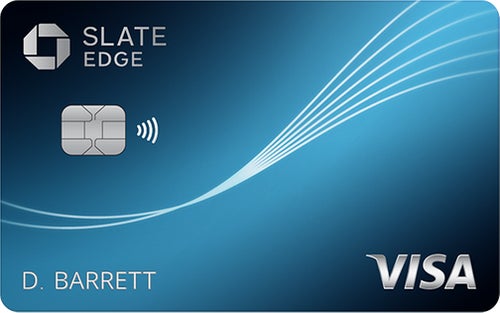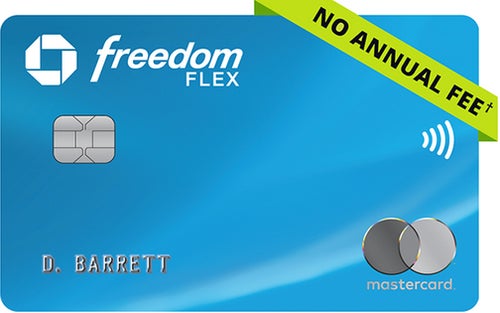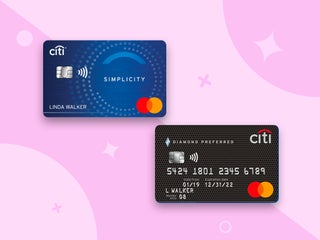Summary
If you’re choosing between the Chase Slate Edge and the Chase Freedom Flex, you’ll need to weigh a balance transfer offer against ongoing rewards.
The content on this page is accurate as of the posting date; however, some of our partner offers may have expired. Please review our list of best credit cards, or use our CardMatch™ tool to find cards matched to your needs.
If you’re struggling under the weight of a large credit card balance, you may be looking for a card that will let you transfer your debt without interest accumulating immediately, such as the Chase Slate Edge℠*. However, the Chase Freedom Flex® card is an alluring option if you’re looking for rewards and more ongoing value – but it isn’t well suited for balance transfers since it doesn’t offer a zero-interest intro balance transfer APR like the Chase Slate Edge does.
See related: Best balance transfer credit cards
Ultimately, the Chase Slate Edge versus Freedom Flex debate comes down to what you’re looking for in a card. The Chase Freedom Flex card lets you earn impressive rewards on every purchase and carries valuable long-term benefits, but you should probably consider the Slate Edge card if your main interest is transferring your balance to a Chase credit card. If you’re looking to avoid interest on both purchases and transferred balances, the Slate Edge is the clear winner since it offers an intro balance transfer APR of 0% for the first 12 months. However, the Chase Slate Edge card’s main drawback is that it doesn’t earn rewards.
Here’s what else we found when comparing the two cards:
Chase Slate Edge vs. Chase Freedom Flex summary
| Card |  Chase Slate Edge℠ |  Chase Freedom Flex® |
| Rewards rate | None |
|
| Sign-up bonus | $100 bonus on your statement when you spend $500 in the first six months | $200 when you spend $500 in the first three months |
| Annual fee | $0 | $0 |
| Estimated yearly rewards value (ongoing, for someone who spends $15,900) | None | $340 |
| APR offers |
|
|
Chase Slate Edge
As Chase’s only balance transfer credit card – and the only Chase card with a zero-interest intro balance transfer period currently – the Slate Edge is perhaps your best option by a long shot for paying off a sizable balance with this issuer. It doesn’t come with amazing 18-month 0% intro APR periods like its Wells Fargo and Citi competitors, but it does offer a reduced balance transfer fee for your first 60 days. You’ll pay 3% or $5 on your balance transfer; for a balance transfer after your first 60 days, you’ll pay 5% or $5, whichever is greater.
The Chase Slate Edge offers no rewards or significant lasting perks, aside from the $100 sign-up bonus if you spend $500 in the first six months. However, it does offer the opportunity to lower your APR over time. The card offers the opportunity to lower your APR by 2% each year if you pay on time and spend at least $1,000 on your card by your next account anniversary.
However, once you pay off that balance you transferred, you likely won’t want to end up in credit card debt again, so hopefully, you won’t need this perk. It is a nice benefit, though, if you run into emergency expenses that you put on your card and need time to pay off.
Pros and Cons
| Pros | Cons |
|
|
Best for someone with a balance switching to a Chase card
If you currently have a balance on your card, you’ll almost certainly be better off with the Slate Edge card if you want to avoid more interest.
The Chase Freedom Flex charges a 5% fee to transfer your balance ($5 minimum fee). By contrast, Chase Slate Edge offers a lower balance transfer fee if you transfer your balance within 60 days of opening your account. For those first 60 days, you’ll be charged $5 or 3% (after the 60 days, it’ll charge $5 or 5%, whichever is greater). That can make somewhat of a difference if you owe several thousand dollars that you want to transfer. For example, you’d have to spend $200 to transfer $4,000 in debt to a Freedom Flex card, in contrast with $120 in fees on the Chase Slate Edge if you made the transfer in your first 60 days with the card.
Although the Freedom Flex card doesn’t charge interest on purchases for the first 15 months (then a 14.99% to 24.74% variable APR), it encourages bonus category spending to maximize your cash back. Cardholders may then be tempted to continue packing on debt that adds to their balance after the intro APR period ends. Meanwhile, the Slate Edge encourages you to make consistent on-time payments with its offer to lower your APR 2% each year if you pay on time and spend at least $1,000 on your card by your next account anniversary.
With those points in mind, the Slate Edge is the more practical option of the two if you want the best opportunity to keep a minimal card balance. Just keep in mind that the Slate Edge does charge a 5% balance transfer fee once you’ve owned the card for longer than 60 days, so you’ll want to transfer your balance right away to snag the 3% fee.
Chase Freedom Flex
The Chase Freedom Flex is the clear winner if your balance is small enough to quickly pay off before switching so that a balance transfer isn’t necessary or if your main concern is interest from big purchases on the horizon.
Although it doesn’t offer an intro balance transfer APR period, you can still keep interest on future purchases at bay with a 15-month 0% intro purchase APR (then 14.99% to 24.74% variable). On top of offering one of the most accessible sign-up bonuses in its class, the Freedom Flex card also provides some of the best reward rates among no-annual-fee cash back cards.
Choosing the Freedom Flex also future-proofs your wallet if your plan is to upgrade to a higher-caliber Chase Ultimate Rewards card. The Freedom Flex pairs nicely with Chase travel cards since it covers bonus categories outside travel cards’ typical dining and travel purchases. You can then pool your rewards with an Ultimate Rewards card that offers a 25% to 50% boost in redemption value toward travel bookings. No matter what your next step is, the Freedom Flex is a solid all-around card worth holding onto.
Pros and Cons
| Pros | Cons |
|
|
Best for someone who wants to earn rewards
Unlike the Slate Edge, the Freedom Flex card offers a solid rewards program for popular everyday expenses. The Freedom Flex card offers 5% cash back on rotating categories you activate each quarter (on up to $1,500 in combined purchases per quarter, then 1%), which often include grocery stores, top online shopping retailers, gas stations and more. If you’re not as big of a seasonal spender, then the 5% on Chase Ultimate Rewards travel and Lyft purchases (Lyft offer through March 2022) plus 3% back on dining and drugstore purchases offer a bed of consistency you won’t find with many other rotating category cards.
In addition, the Freedom Flex card offers a $200 sign-up bonus that’s one of the easiest to reach among competing cards. You just need to spend $500 in combined purchases during the card’s first three months to get it. Both the sign-up bonus and the cash back rewards are reason enough to seriously consider the Freedom Flex, but the solid intro purchase APR makes sure any rewards from big purchases on the horizon won’t be swallowed up by interest.
First-year rewards value ($15,900 spend)
| Chase Slate Edge | Chase Freedom Flex |
| $100 (sign-up bonus) | $15,900 x 1.72% average rewards rate + $200 sign-up bonus = $473.48 |
Which card is right for you?
The Chase Slate Edge versus Chase Freedom Flex battle boils down to whether you carry a balance prior to switching cards. If you’ve got a manageable balance and you’re looking for a rewards card you can use for everyday purchases once you’ve paid what you owe, the Chase Freedom Flex card is a solid choice.
However, the Slate Edge offers an intro APR offer of 0% for 12 months for balance transfers and purchases, followed by its variable APR of 14.99% to 23.74%. It also offers a lowered balance transfer fee for the first 60 days.
That said, 12 months isn’t an especially long time to knock out a balance if you owe several thousand dollars and can only afford to pay a few hundred dollars at a time. If you don’t think you can pay your whole balance within the Slate Edge card’s 12-month intro period, then you may want to consider another card entirely with a longer balance transfer period.
Bottom line
Both the Chase Slate Edge and the Chase Freedom Flex credit cards are solid options for their intro purchase APR offers, but the Chase Slate Edge has a very narrow appeal. Other balance transfer credit cards can offer longer zero-interest periods, but the Slate Edge does offer the opportunity to lower your APR over time (terms apply). If you’re trying to put your foot in the door so you can jump to a premium Chase card down the road, the Freedom Flex delivers an excellent long-term value that won’t become obsolete after you upgrade. But if you want to move to a Chase card with a balance in tow, the Chase Slate Edge is the more viable option.
*All information about the Chase Slate Edge has been collected independently by CreditCards.com and has not been reviewed by the issuer.
Editorial Disclaimer
The editorial content on this page is based solely on the objective assessment of our writers and is not driven by advertising dollars. It has not been provided or commissioned by the credit card issuers. However, we may receive compensation when you click on links to products from our partners.






